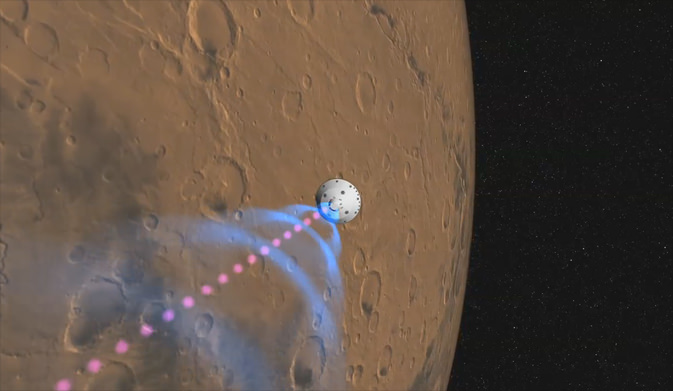Image caption: This artist’s still shows how NASA’s Curiosity rover will communicate with Earth during landing. As the rover descends to the surface of Mars, it will send out two different types of data: basic radio-frequency tones that go directly to Earth (pink dashes) and more complex UHF radio data (blue circles) that require relaying by orbiters. NASA’s Odyssey orbiter will pick up the UHF signal and relay it immediately back to Earth, while NASA’s Mars Reconnaissance Orbiter will record the UHF data and play it back to Earth at a later time. Image credit: NASA/JPL-Caltech
Curiosity is just hours away from ‘do or die’ time and the high stakes and harrowing “7 Minutes of Terror” after an 8 month journey to touchdown on the Red Planet and potentially make historic discoveries that could ultimately answer the question ‘Are We Alone?’
An armada of spacecraft are converging at Mars for the historic landing of NASA’s Curiosity Mars Science Lab rover, the most daring, daunting and complex robotic mission that NASA has ever attempted. See the Video below
“Tonight is the Super Bowl of Planetary Exploration,” said Doug McCuistion, director of the Mars Exploration Program at NASA Headquarters, at a NASA JPL news briefing on Sunday (Aug. 5). “One yard line, one play left. We score and win, or we don’t score and we don’t win.”
“We are about to land a rover that is 10 times heavier and with 15 times the payload [compared to earlier rovers]. No matter what happens, I just want the team to know I am incredible proud and privileged to have worked with these guys and gals.”
“This is the most challenging landing we have ever attempted.”
“Mars Odyssey and Mars Reconnaissance Orbiter (MRO) are in good shape to relay the entry, descent and landing data.”
The trajectory to the atmospheric aim point is so precise that engineers decided to cancel the last course correction maneuver firing planned for today.
Tonight at around 1 AM EDT, Curiosity smashes into the Martian atmosphere at over 13,200 MPH (5,900 m/s) leading to an unprecedented entry, descent and landing sequence culminating in the never before tried “skycrane maneuver” and touchdown at 0 MPH just 7 minutes later astride a 3 mile (5 km ) mountain inside Gale Crater. Mount Sharp represents perhaps millions to perhaps billions of years of Mars geologic history stretching from the ancient wetter time to the more recent desiccated era.
“The team and the spacecraft are ready,” said Adam Steltzner, MSL Entry, Descent and Landing Lead engineer JPL. “We did everything possible to deserve success tonight, although as we all know we can never guarantee success. I am rationally confident and emotionally terrified and ready for EDL.”
Video Caption:This artist’s animation shows how orbiters over Mars will monitor the landing of NASA’s Curiosity rover.The animation starts with the path of NASA’s Mars Science Laboratory spacecraft capsule — which has the Curiosity rover tucked inside — speeding towards its Martian landing site in Gale Crater. Then, the paths of NASA’s Mars Odyssey orbiter and Mars Reconnaissance Orbiter become visible. Curiosity will be sending some basic radio-frequency tones straight back to Earth during its entry, descent and landing, on Aug. 5 PDT (Aug. 6 EDT). But sending more detailed engineering data about the landing is more complicated. Those kinds of data will be sent by Curiosity to the orbiters Odyssey and MRO, which will then relay them back to NASA’s Deep Space Network antennas on Earth. Curiosity can only send the data to Odyssey and MRO when it can see the orbiters — as soon as they rise above and before they set below the Martian horizon. Image Credit: NASA/JPL-Caltech
The 6 wheeled SUV sized rover Curiosity is scheduled to touchdown inside Gale Crater at about 1:31 a.m. EDT (531 GMT) early on Aug. 6 (10:31 p.m. PDT on Aug. 5).
Under the best circumstance, the first signals from the surface could be transmitted via Odyssey within a few minutes of touchdown.
Curiosity is a robotic geologist and a roving chemistry lab with 10 state-of-the-art science instruments that will collect and analyze soil and rock samples and zap rocks from a distance with a laser to search for carbon in the form of organic molecules – the building blocks of life.
“We will attempt to have the MRO HiRISE camera point at MSL and get an image of it the final phases of its descent going down to Mars,” said McCuistion. “This will be difficult because of all the gyrations by the spacecraft. It’s pretty challenging. It will be very tough. We were lucky to get one of Phoenix. I am hopeful”
“We have the opportunity for untold discoveries. We couldn’t even imagine going to this place on Mars a few years ago.”
“If we are successful, it will be one of the greatest feats in exploration ever!”
Watch NASA TV online for live coverage of the Curiosity landing on Aug. 5/6 starting at 11:30 pm EDT:
www.mars.jpl.nasa.gov or www.nasa.gov


2 Sominex + 1 Melatonin = “Wake me up when it’s over” I’ll see y’all in the morning, I’m going to bed after Falling Skies tonight.
What ever happened to equivalency of units. 13,200 MPH (5,900 m/s)?
You’d mean 13, 200 mph (21,200 kmh) I’d think.
Also 0 mph is stationary. Why not just say that?
Actually, this is not ken’s fault, it is again the press releases from NASA as per usual.
There is also a problem with the precision of the numbers. They say; at;
http://www.nasa.gov/mission_pages/msl/index.html
If they new anything about science, the miles numbers should be rounded to the same level of precision. I.e. 58,000 kilometres and 3800 meters per second.
If you wonder what science, science in schools, and the US is in continued decline, this shows some of the reasons. At least Ken here obviously remembers his science lessons even though he has fallen into the trap via NASA publicity’s sloppiness.